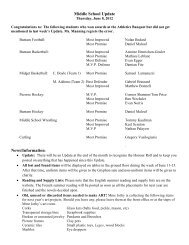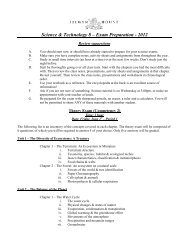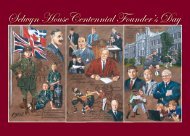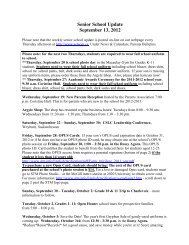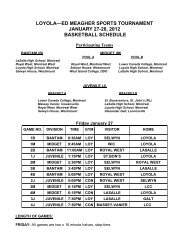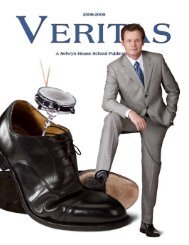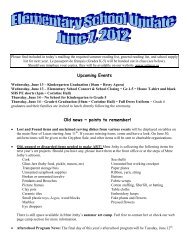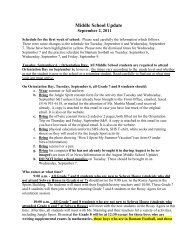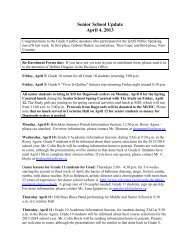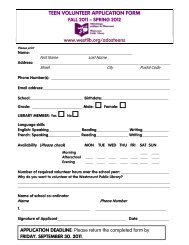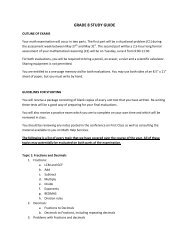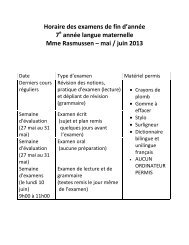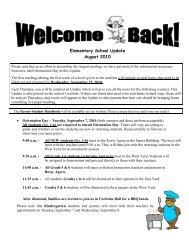Middle School Update - Selwyn House School
Middle School Update - Selwyn House School
Middle School Update - Selwyn House School
Create successful ePaper yourself
Turn your PDF publications into a flip-book with our unique Google optimized e-Paper software.
<strong>Middle</strong> <strong>School</strong> <strong>Update</strong><br />
April 29, 2010<br />
Congratulations!<br />
• A couple of weeks ago, the Grade 8 students wrote Scholastic Challenge 2010, a<br />
competition which tests overall knowledge. Ulysses Pamel came first in the province.<br />
The top four scores, which constituted our team score were: Ulysses Pamel, Sam<br />
Stein, Michael Kounadis, and Jeremy Herman. Bravo! 82% of our students<br />
exceeded the national average.<br />
News/Information<br />
• Please note that the schedule for the last two weeks of school, May 31-June 11 is<br />
attached. The first week maintains the regular schedule of the day, 8:15 to 2:45 and<br />
there will be performance assessments as well as review and exam preparation. There<br />
will be no physical education that week. The second week is formal examinations,<br />
and students will arrive at 8:45 for a 9:00 start. Most exams are two hours. Exam<br />
preparations sheets for all subjects will be attached to next week’s <strong>Update</strong> email.<br />
• Tomorrow is the last day for the Café Red Room. This is an initiative that Senior<br />
<strong>School</strong> student Erik Vincelli-Gregory brought to fruition. Every day this week,<br />
coffee, hot chocolate and Tim Horton’s donuts have been for sale from 7:15 to 8:15<br />
a.m. The proceeds will be sent to the Canadian base in Kandahar and coupons for the<br />
Tim Horton’s there will be distributed to the Canadian Forces serving there. All are<br />
welcome to drop by and partake.<br />
• From Hal Hannaford<br />
o Report on French Teaching in Elementary <strong>School</strong> at <strong>Selwyn</strong> <strong>House</strong>:<br />
Attached you will find this important report. The English and French versions<br />
are included. A special thanks to Board members and Old Boys Charles<br />
Porteous ('84) and Jonathan Goldbloom ('72) for their help and guidance.<br />
AND...an extra special merci to Claudine Martel and Kathy Funamoto who<br />
worked so hard to create an accurate document. Their dedication and effort<br />
are impressive. We thought it was important to share the outcome to our entire<br />
community. More work to be done but we are off to a great start.<br />
o The <strong>Selwyn</strong> <strong>House</strong> community is a special one. It is a place where hopefully,<br />
we can instill in all our boys the value of looking after one another. William<br />
(Bill) Brock (son Phillip is in Grade 9) has quite a story. Bill has also done a<br />
great deal to help the school. I thought his tale was compelling enough to<br />
share with all of you. You can read through his letter to me and then I leave it<br />
up to you to determine how you may want to support this worthwhile and<br />
courageous project. It is always important to be aware of adventures from<br />
within the <strong>Selwyn</strong> <strong>House</strong> community.
• Good luck to our <strong>Middle</strong> <strong>School</strong> boys at the Robotics Competition tomorrow and<br />
Saturday. Their successes will be published here next week.<br />
• Thanks to all the families that volunteered last Sunday for the end-of-the-month<br />
lunch for the less fortunate at Christ Church Cathedral. They left no dish unwashed!<br />
• Please note that the GMAA has rescheduled (due to the snow) the Halo Race that<br />
was to have taken place on Wednesday, April 29. It is now scheduled for Wednesday,<br />
May 5. Because there was already a French field trip scheduled, the ten Grade 7’s<br />
scheduled to run the Halo Race will have to wait until next year – and hope that snow<br />
does not force another postponement.<br />
• Are you still wondering what to do this summer Discover the Shanghai World<br />
Expo and China from July 12-22, 2010. Yamin Zhang (Sean Gong’s mother in<br />
Grade 9) is the cultural coordinator at the Montreal Chinese newspaper, Seven Days.<br />
In March, they took a group of students from Villa Maria to China. They have<br />
organized another trip open to students and parents from Grade 7-11 at <strong>Selwyn</strong> <strong>House</strong><br />
and The Study, leaving on July 12. See the attached flyer for detailed itinerary and<br />
costs. The minimum number of people to run the trip is 10 and the maximum is 40.<br />
The supervisor/student ratio is 1 adult per 20 students. Mrs. Zhang will be going on<br />
the trip herself and possibly a <strong>Selwyn</strong> <strong>House</strong> teacher (depending on the number of<br />
interested students and parents). There will be an information session about the trip<br />
on Wednesday, May 12 at 6:00 p.m. in the Rossy Agora. Payment is due by May 17<br />
in order to secure airline tickets. For more information, please contact Yamin Zhang<br />
at yaminzhang@sympatico.ca or Courtney Prieur at prieur@selwyn.ca / 514-931-<br />
9481 ext. 2228.<br />
• Please remind your son (and provide him with it) to use sun screen if he has a game<br />
or meet or tournament outside. The sun is now strong enough to do damage in a short<br />
period of time. Many fields, courts and tracks do not have shade available.<br />
• Summer uniform will coming up in a few weeks (the date will be announced soon),<br />
so now is the perfect time to make sure that shirts from last year are still in good<br />
shape and fit. If they are too small, the shirt tails do not stay in. Shirts must be clean,<br />
pressed and have all the buttons. Pants are regular uniform pants. Shorts are not<br />
permitted in <strong>Middle</strong> <strong>School</strong>. Belts are required and socks are to be grey and full size,<br />
not half socks. Dark leather shoes (not shoes that resemble running shoes) remain the<br />
standard for the uniform. The only items of clothing that can be worn with a summer<br />
shirt are the <strong>Selwyn</strong> blazer, <strong>Selwyn</strong> sweater vest or <strong>Selwyn</strong> sweater; hoodies etc are<br />
not permitted. Students who do not wear the summer uniform well will lose the<br />
privilege of wearing it and will be required to wear full uniform. Until summer<br />
uniform is announced as permissible, students must maintain their regular uniform<br />
• Lost and Found: There are five blazers in Ms. Manning’s office, various sizes, and<br />
none of them have a name in them. Two have a name blacked out, but no new name<br />
added. As well, an almost brand-new pair of black Geox shoes (slip on, size 40) in a<br />
Brown’s shopping bag have been languishing in the Lost and Found box for months.<br />
If any of these items sound familiar, ask your son to go to the Lost and Found on the<br />
second floor or to see Ms. Manning for a blazer.<br />
• Gryphon Sale Organizers are ready to collect outgrown uniforms for the next sale.
High demand items are: SHS blazers, crested sweaters, blue dress shirts, gray pants<br />
and athletic wear. Please wash or dry clean all the clothing and drop it off at the Front<br />
Office until May 5. Many thanks. Proceeds go to the Nancy Pitfield Endowment<br />
Fund.<br />
• Grade 8 parents: Only one more opportunity remains to volunteer for the Christ<br />
Church end-of-the-month lunches: May 30. If you would like to sign up for next<br />
month, please contact Miss Manal at marlita@selwyn.ca or ex. 2235.<br />
Upcoming Events<br />
• Friday, April 30 and Saturday, May 1 is the 6 th Annual Junior Robotics<br />
Competition.<br />
• Sunday, May 2, Les Amis de la Montagne is holding a clean-day on Mount Royal.<br />
<strong>Selwyn</strong> <strong>House</strong> will be participating along with ECS. Students and their families are<br />
invited to attend. There are three activities that students and their families can choose:<br />
1. Cleaning the forest floor (age 6 and up)<br />
2. Tree planting (age 13 and up)<br />
3. Pruning buckthorn (age 16 and up)<br />
Students who wish to attend but do not have a family member to go with them will be<br />
supervised by a <strong>Middle</strong> <strong>School</strong> teacher. Registration is between 8:45 a.m. and 9:30.<br />
The work period is 10:00 to 12:00. Those who wish to stay after the work is done can<br />
bring a lunch (drinks and snacks will be provided), and there will be kiosks and a<br />
guided walk on the mountain for those interested in making a day of it. Students and<br />
their families who are interested in being part of this event should sign up with<br />
Miss Manal (ex. 2235 or Marlita@selwyn.ca).<br />
• Wednesday, May 4, Regular breakfast will be cancelled from 7:15-8:30 a.m. in<br />
Coristine Hall due to the Grade 11 Mother/Son breakfast<br />
• Wednesday, May 5, Grade 7 will visit Chateau Ramezay. The boys will need to<br />
bring a lunch including something to drink. They will leave the school at 12:15 and<br />
return at 3:00. They will not have a Period 5 that day; consequently, they will be<br />
dismissed as soon as they arrive back at school, approximately 3:00.<br />
• Thursday, May 6 in the Lucas Seminar Room from 1:00 – 4:00 will be a Gryphon<br />
Sale (second-hand uniform sale).<br />
• Thursday, May 6 is the <strong>Selwyn</strong> <strong>House</strong> Fair. Please see the attached flyer.<br />
• Friday, May 14 is the McGill All Science Challenge.<br />
• Friday, May 21 is a half day of regular classes. Dismissal will be at 12:30.<br />
• Monday, May 24, variously know as Victoria Day or Dollard des Ormeaux Day<br />
is a holiday, and the school will be closed.<br />
• Wednesday, May 26 is the Athletic Banquet. A letter regarding those who should<br />
attend is attached to this email.<br />
• Friday, May 28 is the last day of regular classes and the last day of physical<br />
education. The students should clean out their physical education lockers on this day.
May and June 2010<br />
<strong>Middle</strong> <strong>School</strong> Assessment and Exam Calendar<br />
Week 1<br />
Period 1<br />
Period 2<br />
Note: French and math teachers will identify the periods for their respective classes.<br />
Monday, May 31 Tuesday, June 1 Wednesday, June 2 Thursday, June 3<br />
Friday, June 4<br />
Grade 7 Grade 8 Grade 7 Grade 8 Grade 7 Grade 8 Grade 7 Grade 8 Grade 7 Grade 8<br />
Math-Sit.<br />
Science Lab Math-Sit.<br />
Science Lab<br />
Problem<br />
Exam Problem<br />
Exam<br />
Math-Sit.<br />
Problem<br />
French 1<br />
(FLM), Day 1<br />
or Study Hall<br />
French 2<br />
(Reg), Day 1<br />
or Study Hall<br />
Coristine<br />
Study Hall<br />
Math-Sit.<br />
Problem<br />
English 2 French 2<br />
(Reg), Day 2<br />
or Study Hall<br />
French 1<br />
(FLM), Day 2<br />
and Math<br />
French 2<br />
(Reg.), Day<br />
3 and Math<br />
History ES French 1<br />
(FLM), Day<br />
3 and Math<br />
Coristine<br />
Study Hall<br />
Drama<br />
Course -<br />
Presentations<br />
for all<br />
History ES<br />
French 1<br />
(FLM), Day 3<br />
& math<br />
Geo Exam<br />
Prep<br />
Period 3 French 1<br />
(FLM), Day 1<br />
and Study<br />
Hall and<br />
Locker clean<br />
up<br />
Lunch<br />
Period 4 French 2<br />
(Reg.), Day 1<br />
and Study<br />
Hall and<br />
Locker clean<br />
up<br />
English 1 English 1 Study Hall French 2<br />
and Locker (Reg.), Day 2<br />
clean up and Math<br />
English 2<br />
Geo Exam<br />
Prep<br />
English 3 English 3 French 1<br />
(FLM), Day 2<br />
or Study Hall<br />
History ES English 4 French 2<br />
(Reg), Day<br />
3 & math<br />
English 5 English 6<br />
History ES<br />
Drama<br />
Course -<br />
Presentations<br />
for all<br />
MS Lunch and Awards<br />
Week 2<br />
Monday, Monday, Tuesday, Tuesday, Wednesday, Wednesday, Thursday, Thursday, Friday, June Friday, June<br />
June 7 June 7 June 8 June 8 June 9 June 9 June 10 June 10 11<br />
11<br />
Time Grade 7 Grade 8 Grade 7 Grade 8 Grade 7 Grade 8 Grade 7 Grade 8 Grade 7 Grade 8<br />
9:00 to<br />
11:00<br />
English Exam<br />
(2 h)<br />
French<br />
Exams (2 h)<br />
Math (2 h<br />
& 30 min.)<br />
Geo (90<br />
min.)<br />
Math Exam<br />
(2h)<br />
Geo ( 2 h) French Exam<br />
Day 4<br />
English (2 h)<br />
Science<br />
Theory Exam<br />
(60 min.) &<br />
ERC (60<br />
min.)<br />
Science<br />
Theory<br />
Exam (60<br />
min.)<br />
Resource<br />
Room<br />
9:00 to<br />
11:30<br />
CM in F1 CM in F1 GL in F1 CM in F1<br />
CM in F1<br />
CM CM GL CM CM<br />
12:39 PM MS Exam Schedule 2010 for parents Page 1
<strong>Selwyn</strong> <strong>House</strong> Fair 2010<br />
Thursday May 6, 2010<br />
Elementary Grandparents’ tea: Rossy Agora<br />
Grade 3,4,6: 12:30 p.m. – 1:30 p.m. Grade K, 1: 1:30 p.m. -2:30 p.m. Grade 5, 2: 2:30 -3:30 p.m.<br />
Art fair 2:00 p.m.<br />
Année Lieu Oeuvre exposée<br />
Maternelle Agora élémentaire Des dragons tirés de notre imaginaire<br />
Courte pointe blanche en relief<br />
1e année 3e étage Mosaïque à la manière de Kandisky<br />
Une ville en 3D<br />
2e année 3e étage Surprise!<br />
3e année Rossy Agora Hommage aux jeux olympiques de 2010<br />
3e étage<br />
Collage à la manière de Matisse<br />
3e étage<br />
Un oiseau pour Laliberté<br />
4e année 3e étage Oiseau-Soleil<br />
Agora élémentaire Lézard d'eau douce<br />
5e année 3e étage Les stars de l'architecture<br />
Agora élémentaire Une mosaïque de mobiles<br />
6e année 3e étage Un prénom sous toute ses formes<br />
Agora élémentaire Chandelles et vases colorés<br />
Maternelle à 6e année Coristine Hall Une mosaïque de couleurs<br />
Semaine du français<br />
7e année 2e étage Créatures métamorphosées<br />
2e étage<br />
Un lapin digne de Lewis Carroll<br />
2e étage<br />
Illustrated Poetry<br />
8e année 2e étage Le petit du monde animalier, vu trois fois<br />
2e étage<br />
Pots d'inspiration aztèque<br />
2e étage<br />
Illustrated Ballads<br />
7e et 8e MS-4 Géographie et Français<br />
9e année Coristine Hall Autoportraits à la manière d'Escher<br />
Coristine Hall Autoportraits à la manière de Hockey<br />
Mixed media pieces<br />
10e année<br />
Classe d'art - 2e étage Une maison, de la plus antique à la plus moderne<br />
Printmaking inspired by Nancy Spero<br />
11e année<br />
Classe d'art - 2e étage Un aspect de MOI, sous une autre forme<br />
Veuillez noter que certaines oeuvres ont été encadrées et exposées ailleurs que dans les lieux indiqués. Nous vous aiderons à les localiser.<br />
Gryphon Sale: 1:00 p.m. – 4:00 p.m. Lucas Seminar Room<br />
Grade1: classroom activities 2:30 p.m. – 3:10 p.m. (1A, 1B)<br />
Grade 3 & 4: Storytelling 2:00 p.m. – 3:00 p.m. (3A, 3B, 4A, 4B)<br />
Grade 6A: Museé de cire animé 2:00 p.m. – 3:00 p.m. (6A)<br />
Grade 6B: Museé de cire animé 3:00 p.m. – 4:00 p.m. (6B)<br />
Jazz Cabaret: 7:00 p.m. Featuring: Senior Jazz Band Special guests: Jazz Storm (ECS<br />
vocal jazz ensemble with the SHS senior jazz band) Grade 7 & 8 jazz bands
2010<br />
Monday, September 6<br />
Labour Day<br />
Tuesday, September 7<br />
Student Orientation Day (Grades 1 to 11)<br />
Welcome Back BBQ<br />
Wednesday, September 8<br />
Classes Begin (Grades 1 to 11)<br />
Thursday, September 9<br />
Rosh Hashanah - <strong>School</strong> Closed<br />
Friday, October 8<br />
Terry Fox Run - Half Day<br />
(Grades K to 11)<br />
Monday, October 11<br />
Thanksgiving - <strong>School</strong> Closed<br />
Wednesday, October 13<br />
Grades KA<br />
Parent/Teacher Interviews 4:00-8:00 p.m.<br />
Thursday, October 14<br />
Grade KB and Grades 1 and 2<br />
Parent/Teacher Interviews 4:00-8:00 p.m.<br />
Friday, October 29<br />
Grades K to 6<br />
Half Day – No lunch served<br />
Pedagogical Day - afternoon<br />
Thursday, November 4<br />
Grades 3 to 6<br />
Parent/Teacher Interviews 4:00-8:00 p.m.<br />
Friday, November 5<br />
Grades 3 to 6<br />
Parent/Teacher Interviews 8:00 a.m.-4:00 p.m.<br />
No Classes (Grades 3-6 only)<br />
Thursday, November 11<br />
Grades 7 to 11<br />
Parent/Teacher Interviews 1:30-8:00 p.m.<br />
Dismissal at 12:30 p.m. (Grades 7-11 only)<br />
Friday, November 12<br />
Grades 7 to11<br />
Parent/Teacher Interviews 8:00 am-12:00 p.m.<br />
No Classes (Grades 7-11 only)<br />
Important Dates for 2010 – 2011<br />
2010 (cont’d)<br />
Monday, November 15<br />
Mid-Term Holiday - <strong>School</strong> Closed<br />
Thursday, November 18<br />
Grades K to 2<br />
Parent/Teacher Interviews 4:00-8:00 p.m.<br />
Friday, November 19<br />
Grades K to 2<br />
Parent/Teacher Interviews 8:00 a.m.-4:00 p.m.<br />
No Classes (Grades K-2 only)<br />
Thursday, November 25<br />
Founder’s Day<br />
Friday, November 26<br />
Founder’s Day Holiday<br />
<strong>School</strong> Closed<br />
Thursday, December 23<br />
Winter Break Begins (K to11)<br />
2011<br />
Monday, January 10<br />
Pedagogical Day - No Classes (Grades K to 11)<br />
Tuesday, January 11<br />
Students Return from Winter Break<br />
Thursday, January 27<br />
Grades 3 to 6<br />
Parent/Teacher Interviews 4:00-8:00 p.m.<br />
Grades 7 to 11<br />
Parent/Teacher Interviews 1:30-8:00 p.m.<br />
Dismissal at 12:30 p.m. (Grades 7-11 only)<br />
Friday, January 28<br />
Grades 7 to 11<br />
Parent/Teacher Interviews 8:00 am-12:00 p.m.<br />
No Classes (Grades 7-11 only)<br />
Monday, February 7<br />
Mid-Winter Break - <strong>School</strong> Closed<br />
Thursday, February 24<br />
Grades 1 to 6<br />
Student Led Interviews 3:00-7:00 p.m.<br />
(Grades K-6 early dismissal @ 2:30 p.m.)<br />
2011 (cont’d)<br />
Friday, February 25<br />
Grades 1 to 6<br />
Student Led Interviews 8:00 a.m.-12:00 p.m.<br />
No Classes (Grades K-6 only)<br />
Monday, February 28<br />
March Break Begins<br />
Monday, March 14<br />
Pedagogical Day - No Classes (Grades K to 11)<br />
Tuesday, March 15<br />
Students Return from March Break<br />
Friday, April 22<br />
Good Friday - <strong>School</strong> Closed<br />
Monday, April 25<br />
Easter Monday - <strong>School</strong> Closed<br />
Friday, May 20<br />
Grade 11 Graduation Dinner/Dance<br />
Elementary <strong>School</strong> Track Meet<br />
Half Day - No lunch served<br />
(Grades K-11)<br />
Monday, May 23<br />
Victoria/DDO Day - <strong>School</strong> Closed<br />
Thursday, June 9<br />
Grades K to 5 – Last Day<br />
Friday, June 10<br />
Grade 6 Graduation<br />
Last Day for <strong>Middle</strong> <strong>School</strong><br />
Half Day - No lunch served<br />
Tuesday, June 21<br />
Senior <strong>School</strong> - Last Day of Exams<br />
Wednesday, June 22<br />
Grade 11 Graduation Ceremony<br />
Friday, June 24<br />
Legal Holiday - <strong>School</strong> Closed<br />
____________________________________________________________________________<br />
95, chemin Côte St-Antoine, Westmount (Québec) Canada H3Y 2H8<br />
Tél.: 514-931-9481 Fax: 514-931-6118<br />
www.selwyn.ca Last updated 4/28/10
The 2010 Annual <strong>Selwyn</strong> <strong>House</strong> <strong>School</strong><br />
Parent and Son Athletic Banquet<br />
April 26, 2010<br />
Dear Athlete and Parents,<br />
The school will complete another successful year in athletics, and we want to inform you of the format for our<br />
athletic banquet on May 26, 2010. If your son is in Grade 8 to 11 and he has played on a school team or in a<br />
competitive individual sport, he is expected to attend our annual athletic banquet. He may invite both his parents.<br />
Elementary and Grade 7 student award winners are also invited and have received a special invitation to the<br />
banquet. <strong>School</strong> dress is required.<br />
The banquet will start with a reception in the Rossy Agora at 4:30 p.m. followed by dinner at 6:15 p.m. The awards<br />
ceremony starts at 7:30 p.m. The athletic banquet will be held in the Coristine Hall at the school. All athletes and<br />
their parents are required to reserve before May 15, via email only, with Ms. Debbie Dragone at<br />
draggod@selwyn.ca. Please reserve as soon as possible.<br />
The cost of the evening will be $30.00 per adult. There will be no charge for students/athletes. Payment by cheque<br />
is required when your reserved tickets are picked up. There will be an additional charge of $10 per ticket for tickets<br />
purchased after May 15. . Please note: tickets are not refundable.<br />
We look forward to your attending our annual Athletic Banquet.<br />
Sincerely,<br />
Steve Mitchell<br />
Athletic Director<br />
The format for the evening is:<br />
4:30 p.m. Reception in the Rossy Agora<br />
6:15 p.m. Dinner will be a roast beef dinner with a vegetarian meal available upon request.<br />
7:30 p.m. Awards<br />
Announcement of the “Athletes of the Year”<br />
Announcement of the “2010 Sportsman Guild”
May 2010<br />
MON TUE WED THU FRI SAT/SUN<br />
26<br />
27<br />
28<br />
29<br />
30<br />
1<br />
Week 1<br />
Grade 10 YPI<br />
SHS Tennis<br />
French<br />
High <strong>School</strong><br />
Outdoor Ed Golf<br />
Fair<br />
Tournament<br />
Conference<br />
Allstar Football<br />
to Malone, NY<br />
8:30 AM to<br />
1:30 PM to 3:30<br />
Game<br />
10:30 AM<br />
Parent<br />
PM<br />
6th Annual<br />
Location:<br />
Association<br />
Location: The<br />
Outdoor Ed Golf<br />
Robocup Junior<br />
Macaulay Gym<br />
General<br />
Study<br />
to Malone, NY<br />
Robotics<br />
Meeting<br />
Competition<br />
Grade 10 YPI<br />
8:15 AM<br />
Big Brothers<br />
6th Annual<br />
8:00 AM to 4:00<br />
Finals<br />
Location: Rossy<br />
Meeting<br />
Robocup Junior<br />
PM<br />
5:30 PM<br />
Agora<br />
3:30 PM to 4:30<br />
Robotics<br />
Location: l'ecole<br />
Location: Rossy<br />
PM<br />
Competition<br />
primaire St.<br />
Agora<br />
Baseball - SHS<br />
Location:<br />
8:00 AM to 2:30<br />
Monica<br />
vs LCC<br />
1:00 PM<br />
Coristine Hall<br />
PM<br />
Location: l'ecole<br />
2<br />
primaire St.<br />
Monica<br />
3<br />
4<br />
5<br />
6<br />
7<br />
8<br />
Week 2<br />
Grades 10 & 11<br />
GMAA Halo<br />
Elementary<br />
Elementary<br />
Elementary<br />
(optional) day<br />
Race<br />
Regional<br />
Regional<br />
Regional<br />
Senior <strong>School</strong><br />
trip to Bishops<br />
Science Fair<br />
Science Fair<br />
Science Fair<br />
AP Exam<br />
Senior <strong>School</strong><br />
Location: Centre<br />
Location: Centre<br />
Location: Centre<br />
(French)<br />
Grade 11<br />
AP Exam<br />
Communautaire<br />
Communautaire<br />
Communautaire<br />
12:00 PM to<br />
Mother & Son<br />
(Calculus)<br />
Lajeunesse<br />
Lajeunesse<br />
Lajeunesse<br />
3:00 PM<br />
Location: Speirs<br />
Breakfast<br />
7:15 AM to 8:30<br />
8:00 AM to<br />
11:00 AM<br />
GMAA Track<br />
Baseball - SHS<br />
9<br />
Seminar Room<br />
AM<br />
Location: Speirs<br />
Meet<br />
vs Kuper<br />
Location:<br />
Seminar Room<br />
1:00 PM<br />
Coristine Hall<br />
SHS Fair<br />
Grade 11 Think<br />
Grade 2 to<br />
First<br />
Biodome<br />
Presentation<br />
Senior <strong>School</strong><br />
9:00 AM to 3:00<br />
with Enrico<br />
AP Exam<br />
PM<br />
Quilico, Class of<br />
(English)<br />
2000<br />
8:00 AM to<br />
Grades K-4<br />
11:15 AM<br />
11:00 AM<br />
outing to view<br />
Location: Rossy<br />
Location: Speirs<br />
play<br />
Agora<br />
Seminar Room<br />
10:00 AM<br />
Location: D.B.<br />
Grade 7 to<br />
Grades K to 6<br />
Clarke Theatre<br />
Chateau<br />
Grandparent<br />
(Concordia<br />
Ramezay<br />
Tea<br />
downtown<br />
12:00 PM to<br />
12:30 PM to<br />
campus)<br />
3:30 PM<br />
3:30 PM<br />
Location: Rossy<br />
Baseball - SHS<br />
Agora<br />
vs LCC<br />
1:00 PM<br />
Gryphon Sale<br />
1:00 PM to 4:00<br />
Grade 2 & 3<br />
PM<br />
Parent Evening<br />
Location: Lucas<br />
7:00 PM to 9:00<br />
Seminar Room<br />
PM<br />
Location: Rossy<br />
Music Cabaret<br />
Agora<br />
7:00 PM to 9:30<br />
PM<br />
Location:<br />
Coristine Hall<br />
10<br />
11<br />
12<br />
13<br />
14<br />
15<br />
GMAA Tennis<br />
GMAA Tennis<br />
Gauss Math<br />
GMAA Tennis<br />
GMAA Tennis<br />
Senior <strong>School</strong><br />
Week<br />
Week<br />
Contest (Grades<br />
Week<br />
Week<br />
Play<br />
7 & 8)<br />
Location:<br />
Week 1<br />
National Denim<br />
GMAA Track<br />
<strong>Middle</strong> <strong>School</strong> -<br />
Coristine Hall<br />
Day - Cure<br />
Foundation<br />
GMAA Tennis<br />
Week<br />
Meet<br />
All Science<br />
Challenge of<br />
16<br />
Senior <strong>School</strong><br />
2010 (all day)<br />
Foire de livre<br />
Foire du livre<br />
Play<br />
Location: McGill<br />
10:00 AM to<br />
8:30 AM to 4:30<br />
Location:<br />
University<br />
4:30 PM<br />
PM<br />
Coristine Hall<br />
Downtown<br />
Location: Lucas<br />
Location: Lucas<br />
Campus<br />
Seminar Room<br />
Seminar Room<br />
Senior <strong>School</strong><br />
GMAA Banquet<br />
Play<br />
6:00 PM<br />
Location:<br />
Coristine Hall<br />
Grade 6B<br />
Drama Class<br />
Field Trip to<br />
Segal Centre<br />
12:00 PM to<br />
3:30 PM<br />
17<br />
18<br />
19<br />
20<br />
21<br />
22<br />
Week 2<br />
Grade 4 Trip to<br />
Grade 5 Trip to<br />
Grade 5 Trip to<br />
Elementary<br />
Old Port<br />
9:00 AM to 3:00<br />
Quebec CIty<br />
Quebec City<br />
<strong>School</strong> Track<br />
Meet - 1/2 day<br />
23<br />
PM<br />
Grade 10 Josten<br />
- no lunch<br />
Grad Ring Order<br />
served<br />
New Parent<br />
($50 deposit)<br />
Reception<br />
12:30 PM<br />
Grade 11<br />
4:30 PM to 6:30<br />
Location: Red<br />
Graduation<br />
PM<br />
Room<br />
Dinner/Dance<br />
Location:<br />
Coristine Hall<br />
Grade 11<br />
Grs. 7 to 10 -<br />
students to visit<br />
1/2 day -<br />
Medecins Sans<br />
dismissal at<br />
Frontieres<br />
12:30 p.m.<br />
"Refugee Camp<br />
in the City"<br />
Last day of<br />
1:00 PM<br />
Senior <strong>School</strong><br />
phys ed<br />
24<br />
25 26<br />
27<br />
28<br />
29<br />
Victoria/DDO<br />
SHS Athletic<br />
GMAA Rugby<br />
Grade 2 to "Nuit<br />
Day - <strong>School</strong><br />
Closed<br />
Banquet @ SHS<br />
(no sports<br />
Championships<br />
Magique a<br />
l'Ecomuseum"<br />
30<br />
p.m.)<br />
Grade 2 to "Nuit<br />
5/27/2010<br />
Week 1<br />
4:30 PM<br />
Magique a<br />
7:00 PM<br />
l'Ecomuseum"<br />
to 5/28/2010<br />
5/27/2010<br />
9:00 AM<br />
7:00 PM<br />
to 5/28/2010<br />
End of Term 2 -<br />
9:00 AM<br />
Grades 7-11<br />
Last day of phys<br />
ed for <strong>Middle</strong><br />
<strong>School</strong><br />
<strong>Middle</strong> <strong>School</strong><br />
Dance<br />
Location:<br />
Coristine Hall<br />
Grade 4<br />
Hepatitis A&B<br />
and chicken pox<br />
vaccinations<br />
1:30 PM<br />
Location:<br />
Elementary Coop<br />
Room<br />
31<br />
1<br />
2<br />
3<br />
4<br />
5<br />
Exams start for<br />
Grade 4 Trip to<br />
Grade 1 to<br />
Elementary<br />
Grades K to 3 to<br />
Grades 9-11<br />
Upper Canada<br />
Village<br />
Ecomuseum<br />
8:30 AM to 3:25<br />
Spring Concert<br />
2:00 PM<br />
Oka Beach (all<br />
day)<br />
6<br />
Week 2<br />
7:30 AM to 5:30<br />
PM<br />
Location:<br />
12th Annual<br />
PM<br />
Parent<br />
Coristine Hall<br />
Alumni &<br />
Association<br />
Friends Golf<br />
Appreciation<br />
Tournament<br />
Tea<br />
12:30 PM<br />
1:30 PM to 3:15<br />
PM<br />
Location: Rossy<br />
Agora
SHS Yearbook<br />
Dear Parents,<br />
Personalize your son’s yearbook by having his name printed in gold lettering on<br />
the front cover. Name stamping is one of the ways to make his yearbook unique. The<br />
Yearbook staff is happy to offer you this service for $10 per book. All 2010 grads will<br />
have their names stamped free of charge.<br />
If you would like to order extra copies of the yearbook, please send a request via<br />
email to the staff advisor, Ms. Julie Heath (heathj@selwyn.ca) before May 14 letting her<br />
know how many extra copies you would like. All students will receive one yearbook and<br />
extra copies are $40.00.<br />
Sincerely,<br />
Colin Fitzpatrick<br />
2010 Yearbook Editor<br />
……………………………………………………………………………………………<br />
Please Print:<br />
Name:______________________________________<br />
(As will appear on cover, 25 characters max)<br />
Grade:_____<br />
(Not printed on cover)<br />
Please send this form with a cheque for $10 made out to <strong>Selwyn</strong> <strong>House</strong> Association to the<br />
attention of Ms. Julie Heath.<br />
Deadline for submissions is Friday, May 14 th , 2010.<br />
L’ASSOCIATION SELWYN HOUSE – SELWYN HOUSE ASSOSIATION<br />
95, chemin Côte St-Antoine, Westmount (Quebec) Canada H3Y 2H8<br />
Tél.: (514) 931-9481 Fax : (514) 931-6118<br />
www.selwyn.ca
Teaching French at <strong>Selwyn</strong> <strong>House</strong>:<br />
Three Decades of Progress in the Elementary <strong>School</strong><br />
Francophone families and <strong>Selwyn</strong> <strong>House</strong> <strong>School</strong><br />
<strong>Selwyn</strong> <strong>House</strong> <strong>School</strong> has emphasized excellence in second language instruction for almost<br />
three decades. As an English language school, SHS has concentrated on developing a French<br />
second language teaching approach that is among the finest in the English private and public<br />
systems in Montreal.<br />
It may be less widely recognized, however, that the leadership of the school has been focused<br />
on meeting the needs of mother tongue French students in terms of language acquisition as<br />
well, with a stated intention to emphasize the needs of these students in curriculum and<br />
resource development since 1979.<br />
This brief report sketches the development of <strong>Selwyn</strong> <strong>House</strong> <strong>School</strong>’s approach to the teaching<br />
and the use of French in Grades K-6 with a particular focus on the approach’s success with<br />
mother tongue French students whose parents want their sons to acquire English while<br />
developing levels of French language skills that will allow them to enter the French language<br />
school system at the secondary level, if that is the choice or the need of the family. The<br />
evidence suggest that these students, like their English speaking classmates, not only benefit<br />
from learning a second language early in life, but by the end of elementary school the two<br />
groups are also equally strong in terms of their academic performance.<br />
History of second language instruction at <strong>Selwyn</strong> <strong>House</strong> <strong>School</strong><br />
The evolution of Quebec society made French second language instruction a critically important<br />
issue for all English language schools in the province, private and public, starting as early as the<br />
1960s. Since that time, massive investments have been made to develop innovative approaches<br />
to French second language instruction. Along the way, there has been extensive, often highly<br />
politicised, public debate over issues such as when a child should begin second language<br />
instruction. Parents often found it difficult to know how to act effectively on their instinct that<br />
their children needed high-quality instruction in both English and French.<br />
Frustration was and continues to be particularly high among francophone parents who wanted<br />
their children to get an early start in their second language but were in a system that only began<br />
English language instruction in Grade 4.<br />
Montreal’s English language schools became worldwide leaders in second language instruction<br />
during this period and healthy competition among schools pushed everyone to innovate and<br />
invest to meet the needs of Quebec families.<br />
SHS’s path to excellence in French second language programming includes many elements that<br />
are now recognized as evidence-based best practices. While sketching a brief history of the<br />
development of this programming, however, it is critical to keep in mind that since 1979, SHS<br />
has been committed to raising the quality and quantity of French language instruction for all<br />
students at the primary level with a stated intention to consider both the mother tongue and<br />
the second language learning needs of francophone students as well.<br />
Page 1 of 5
Teaching French at <strong>Selwyn</strong> <strong>House</strong>:<br />
Three Decades of Progress in the Elementary <strong>School</strong><br />
In 1979, SHS implemented the first of a long series of measures to enhance second language<br />
instruction with the opening of “la Sixième”, the school’s first “immersion” type learning<br />
environment. “Immersion” language instruction was “state of the art” at the time, with an<br />
emphasis on what was characterized as “authentic communication in a natural exchange<br />
setting”. Oral skills were the priority.<br />
Through the 1980s and early 1990s, SHS began to supplement formal French instruction classes<br />
with instruction of other core subjects in French as teaching resources allowed (beginning with<br />
geometry and followed by science and music). At this point, the school also implemented<br />
“streaming” of French with “français langue seconde” and “français langue maternelle” options.<br />
This step was taken in large part to meet the perceived needs of mother tongue francophone<br />
boys.<br />
In 1993, SHS took the step of implementing “la Cinquième”, French immersion beginning in<br />
Grade 5 and continuing in the Grade 6. At this point, SHS teachers were beginning to focus<br />
much more attention on reading and writing skills to complement the emphasis on oral skills<br />
that had characterized the first chapter in the story of enhanced second language programming<br />
at SHS. French immersion Kindergarten was launched in 1994 and by 1996, streaming into<br />
langue seconde and langue maternelle was in place beginning in Grade 3.<br />
By the end of the 1990s, SHS expertise and capacity in second language instruction had<br />
developed to a point where a fundamental “re-think” was in order. The experience of SHS<br />
teachers, backed up by research in educational outcomes and best practices from McGill<br />
University, suggested that a powerful tool for second language learning was to teach basic<br />
reading skills in that second language. It seemed counter-intuitive to some, but the research<br />
showed that reading ability in the mother tongue was not compromised in any way by this<br />
approach and second language acquisition was notably enhanced. A recognized authority on<br />
bilingual education, Dr. Fred Genesee of McGill University, has stated that research is<br />
conclusive:<br />
...reduced exposure to instruction in the L1 (or mother tongue) as a result of participation in<br />
a bilingual program in the elementary or secondary grades does not usually impede the<br />
normal L1 development of majority language students.<br />
With respect to achievement in academic domains, such as mathematics, science, and social<br />
studies, evaluations of the progress of majority language students in bilingual programs<br />
indicate that they generally achieve the same levels of competence as comparable students<br />
in L1 programs. 1<br />
SHS called its approach to second language instruction that included learning how to read in<br />
French “biliteracy” and implemented a teaching program in Grades K-2 that included a heavy<br />
emphasis on French oral skills with the addition of reading instruction in French that gives boys<br />
all the skills they need to read comfortably at a Grade 1 level. All the while, the school was<br />
pushing to teach more subjects in the core curriculum in French and to create opportunities for<br />
1 From “What do we know about bilingual education for majority language students” in T.K. Bhatia &<br />
W. Ritchie (Eds) (2004). Handbook of Bilingualism and Multiculturalism.<br />
Page 2 of 5
Teaching French at <strong>Selwyn</strong> <strong>House</strong>:<br />
Three Decades of Progress in the Elementary <strong>School</strong><br />
the use of French outside the classroom in sports and club-based activities as well. By 2001, 70<br />
per cent of instructional time in K-2 was in French, a ratio that has been maintained to present.<br />
The effectiveness of this innovation led to a decision to begin phasing out “streaming” in French<br />
in 2002. The 2009-2010 academic year is the first where all students in SHS elementary grades<br />
are in an integrated, non-streamed French program.<br />
In terms of teaching resources, hiring has been done so that about two thirds of the school’s<br />
primary level teaching staff are mother tongue francophones. These teachers interact with<br />
students (both inside and outside the classroom) in French only. In addition, a wide range of<br />
student activities and clubs are offered in French. Hockey, for example, is coached exclusively in<br />
French and extracurricular learning opportunities at the primary level include Robotique, Comité<br />
scientifique, Club dictée, Club comprehension de lecture, Génies en Herbes, and Entreprises SHS<br />
inc.<br />
Commenting on the development of second language instruction at SHS, one senior leader said,<br />
“I used to teach French at <strong>Selwyn</strong> <strong>House</strong>; now I teach in French.”<br />
Other teachers and parents have characterized the SHS approach as “le français vivant” with<br />
benefits for boys of any mother tongue. “Both French and English are heard in the corridors and<br />
the playground,” noted Kathy Funamoto, Director of the Junior <strong>School</strong>. “The reality is that we<br />
are witnessing first-hand the breakdown of cultural barriers and the benefits of diversity.”<br />
SHS continues to provide excellent instruction in English in the classroom. About 30% of<br />
instruction is in English in levels K-2, rising to about 50 per cent in levels 3-6. There are extensive<br />
extracurricular activities in both French and English. The success of its mother tongue French<br />
students in English attests to the effectiveness of the SHS environment and teaching approach<br />
for their second language learning needs as well.<br />
As part of the study, several French-speaking parents were interviewed. The following are<br />
samples of what was said. “At home we speak French because we want to ensure that our<br />
children are able to live and work in this province and are proud of our language and our roots.<br />
What has impressed me is that most of his friends from school, although more at ease in<br />
English, understand when I speak to them in French and can respond in the language of<br />
Moliere.”<br />
Another quote: “On any day you walk down the hallways of the Elementary <strong>School</strong> and you hear<br />
French echoing from the classrooms.”<br />
Another quote: “The school makes a real effort to introduce the boys to the French reality of<br />
Quebec through film, TV and theatre.”<br />
Page 3 of 5
Teaching French at <strong>Selwyn</strong> <strong>House</strong>:<br />
Three Decades of Progress in the Elementary <strong>School</strong><br />
The <strong>Selwyn</strong> <strong>House</strong> <strong>School</strong> environment and learning a second language<br />
SHS’s curriculum approach to teaching second languages is rigorous and evidence-based.<br />
Success may be due, however, as much to the <strong>School</strong>’s fundamental approach to education as<br />
the specifics of its French and English second language instruction methods.<br />
Three things characterize education at <strong>Selwyn</strong> <strong>House</strong>, and each can have a powerful and<br />
positive effect on language learning.<br />
The first is the SHS focus on boys and their educational needs. There is extensive research that<br />
speaks to the effectiveness of boys-only schools in terms of learning and academic<br />
achievement. There is also considerable anecdotal, and the beginnings of quantitative, evidence<br />
that this “boys-only effect” is at work in second language learning as well. It is a demonstrated<br />
fact that girls tend to have an advantage over boys in language skill development and that boys<br />
have a tendency to “shut down” in the presence of girls and be more reluctant to participate in<br />
learning opportunities involving language.<br />
Secondly, the small class sizes at SHS allow teachers much more interaction with individual<br />
students; this kind of direct student-teacher contact is particularly important for language<br />
learning. As one SHS French teacher observed, “With our low student-teacher ratio , I teach the<br />
individuals; with 30 students, I can only teach the book.”<br />
A third, less tangible aspect of the SHS teaching environment’s beneficial impact on second<br />
language instruction is the intentional and effective investment of energy in making learning a<br />
pleasurable experience for boys. Research is clear that this may be the single most important<br />
variable in second language learning success—creative teachers and their motivated students.<br />
Preparing for French language secondary school<br />
In spite of the quality and effectiveness of SHS second language instruction, the <strong>School</strong><br />
recognizes that its core programming in French needs to be supplemented for a student who<br />
may want to transition easily into a French language secondary school.<br />
That is why, starting in Grade 3, SHS teachers begin working with francophone parents who<br />
want that option for their child to reinforce French language reading skills and to ensure<br />
enhanced exposure to French language media and culture in the non-school environment. In<br />
some individual cases, the school may advise parents to include some additional formal learning<br />
opportunities in the grammar and structure of the French language.<br />
This kind of partnership is critically important for a boy’s success in high school in French, and<br />
SHS has worked closely with a number of families to create bridges that have led to notable<br />
success for a number of SHS boys in French language secondary schools, both public and<br />
private.<br />
Page 4 of 5
Teaching French at <strong>Selwyn</strong> <strong>House</strong>:<br />
Three Decades of Progress in the Elementary <strong>School</strong><br />
The benefits of bilingual and biliterate education in an environment of “le français vivant”<br />
The intellectual, academic, personal and professional benefits of bilingual education are without<br />
question. The SHS experience demonstrates that elementary school graduates have a solid<br />
foundation in core subjects regardless of the language in which the course had been taught and<br />
their mother tongue.<br />
Parents face difficult choices about how to ensure that their children receive these benefits—<br />
choices that start literally at birth with decisions about home language use and continue right<br />
through to the selection of a university. SHS has developed an approach for K-6 that ensures<br />
strong English language skills while protecting a full range of school choice for mother tongue<br />
francophone boys.<br />
SHS offers an environment where “le français vivant” is the language of instruction and<br />
interaction for most in-class and extra-curricular activities at the primary level. This is<br />
complemented by strong formal instruction in English, creating a compelling option for Frenchspeaking<br />
parents who want their boys to have the benefits of bilingualism while maintaining<br />
their core linguistic identity.<br />
Page 5 of 5
L’enseignement du Français à <strong>Selwyn</strong> <strong>House</strong>:<br />
Trois décennies d’avancement à l’école primaire<br />
Les familles francophones et l’école <strong>Selwyn</strong> <strong>House</strong><br />
Depuis près de trente ans, l’école <strong>Selwyn</strong> <strong>House</strong> vise l’excellence dans l’enseignement des<br />
langues secondes. À titre d’établissement scolaire anglophone, <strong>Selwyn</strong> <strong>House</strong> s’est<br />
appliquée à développer une approche en enseignement du français langue seconde réputée<br />
parmi les institutions scolaires anglophones, tant privées que publiques, à Montréal.<br />
Il est peut-être moins connu, cependant, que la direction de l’école s’efforce de satisfaire les<br />
besoins des élèves francophones non seulement en ce qui a trait à l’acquisition de la langue<br />
comme telle, mais aussi en mettant l’accent sur les besoins de ces élèves tant au point de<br />
vue personnel que scolaire et ce, depuis 1979.<br />
Ce bref document expose les grandes lignes de l’évolution de l’utilisation du français et de sa<br />
méthode d’enseignement, de la maternelle à la sixième année à <strong>Selwyn</strong> <strong>House</strong>. Une<br />
attention particulière sera portée au succès de cette méthode auprès des garçons<br />
francophones dont les parents souhaitent autant l’apprentissage de l’anglais que la<br />
progression des habiletés en français, ce qui leur permettrait, si désiré, de poursuivre leurs<br />
études dans le système scolaire francophone au secondaire. Il devient évident que ces<br />
garçons, tout comme leurs camarades de classe anglophones, sont avantagés par<br />
l’apprentissage d’une langue seconde à un jeune âge puisque les deux groupes, à la fin du<br />
primaire, présentent de tout aussi forts résultats scolaires.<br />
Historique de l’enseignement des langues secondes à <strong>Selwyn</strong> <strong>House</strong><br />
L’évolution de la société québécoise a fait de l’enseignement du français langue seconde un<br />
enjeu important pour toutes les écoles anglophones de la province, aussi bien publiques que<br />
privées, et ce, depuis les années 1960. Des investissements massifs ont dès lors été déployés<br />
pour développer de nouvelles méthodes d’enseignement du français langue seconde. À<br />
travers cela, des débats publics de grande envergure, souvent très politisés ont eu lieu à<br />
propos, entre autres, de l’âge auquel un enfant devrait débuter l’apprentissage d’une langue<br />
seconde. Adhérant à l’importance d’offrir à leurs enfants un enseignement de grande qualité<br />
tant en français qu’en anglais, les parents trouvaient difficile de faire un choix éclairé à ce<br />
sujet. La frustration était et continue d’être palpable, particulièrement chez plusieurs<br />
parents francophones souhaitant que leurs enfants commencent à apprendre l’anglais plus<br />
tôt, mais devant se limiter à un système n’offrant des cours d’anglais qu’à partir de la<br />
quatrième année.<br />
Durant cette période, les écoles anglophones de Montréal sont vite devenues des chefs de<br />
file internationaux en enseignement des langues secondes. Une saine compétition entre les<br />
écoles poussa alors tout le monde à innover et à investir pour satisfaire les besoins des<br />
familles québécoises.<br />
1 / 6
L’enseignement du Français à <strong>Selwyn</strong> <strong>House</strong>:<br />
Trois décennies d’avancement à l’école primaire<br />
Le cheminement vers l’excellence en enseignement du français langue seconde à <strong>Selwyn</strong><br />
<strong>House</strong> propose des méthodes qui sont maintenant adoptées et reconnues comme étant de<br />
bonnes pratiques. Tout en survolant les grandes étapes du développement de ce<br />
programme, il est important de garder en tête que depuis 1979, l’école s’est engagée à<br />
augmenter la quantité et améliorer la qualité de l’enseignement du français pour tous les<br />
élèves du primaire. Tout ceci en tenant compte des besoins d’apprentissage des garçons<br />
dont le français est la langue maternelle et de ceux pour qui il s’agit d’une langue seconde.<br />
En 1979, <strong>Selwyn</strong> <strong>House</strong> mit sur pied la première d’une longue série de mesures pour<br />
accroître la qualité de l’enseignement du français en lançant « la sixième », première classe<br />
d’immersion. L’enseignement par immersion était ce qu’il se faisait de mieux à cette<br />
époque. L’accent était surtout porté sur ce qu’on appelait « la conversation authentique<br />
dans un milieu naturel ». La communication orale était priorisée.<br />
Au cours des années 1980 et au début des années 1990, <strong>Selwyn</strong> <strong>House</strong>, en plus des cours<br />
réguliers de français, commença à offrir l’enseignement de quelques autres matières<br />
principales en français. Tenant compte alors de la disponibilité du corps enseignant, ce fut<br />
d’abord la géométrie, suivie des sciences et de la musique. À ce moment, l’école mit aussi<br />
en place les options « français langue seconde » et « français langue maternelle ». Cette<br />
nouvelle répartition fut dictée en grande partie par les besoins des garçons dont la langue<br />
maternelle est le français.<br />
En 1993, <strong>Selwyn</strong> <strong>House</strong> prit la décision d’implanter «la cinquième», une immersion française<br />
en cinquième année se poursuivant en sixième. À ce moment, pour bonifier le programme<br />
instauré aux premières heures de l’histoire de l’enseignement des langues secondes à<br />
<strong>Selwyn</strong> <strong>House</strong>, les instituteurs commencèrent à accorder beaucoup plus d’attention à la<br />
lecture et à l’écriture. L’immersion française à la maternelle, quant à elle, fut adoptée en<br />
1994 et, en 1996, la répartition des élèves entre les cours de français langue seconde et ceux<br />
de français langue maternelle eut lieu en troisième année.<br />
À la fin des années 1990, la compétence et la capacité de <strong>Selwyn</strong> <strong>House</strong> en enseignement<br />
des langues secondes se sont tellement développées qu’une réévaluation s’imposait.<br />
L’expertise des enseignants, soutenue par les recherches en didactique et bonnes pratiques<br />
de l’Université McGill, laissaient entendre qu’un puissant outil pour l’apprentissage d’une<br />
langue seconde était l’enseignement de simples notions de lecture dans cette langue<br />
seconde. Cela semblait surprenant pour certains, mais les recherches démontraient bien que<br />
les compétences de lecture dans la langue maternelle n’étaient compromises d’aucune<br />
façon par cette approche, et que l’apprentissage de la langue seconde en bénéficiait<br />
significativement. Le Dr Fred Genesee de l’Université McGill, une sommité en éducation<br />
bilingue, abonde dans ce sens :<br />
2 / 6
L’enseignement du Français à <strong>Selwyn</strong> <strong>House</strong>:<br />
Trois décennies d’avancement à l’école primaire<br />
« …une exposition réduite à l’enseignement dans la L1 (la langue maternelle) dans<br />
le cadre d’un programme bilingue à l’école primaire ou secondaire n’entrave<br />
généralement pas le développement normal de la L1 chez la majorité des étudiants<br />
en langue. Quant aux résultats obtenus dans d’autres matières académiques telles<br />
que mathématiques, sciences et sciences sociales, les évaluations des progrès de la<br />
majorité des étudiants en langue inscrits dans des programmes bilingues<br />
démontrent qu’ils atteignent les mêmes niveaux de compétence que les étudiants<br />
inscrits dans des programmes de L1. 1 »<br />
<strong>Selwyn</strong> <strong>House</strong> baptisa son approche à l’enseignement d’une langue seconde doublée d’une<br />
formation en lecture française, « biliteracy ». De plus, l’école instaura un programme<br />
d’enseignement de la maternelle à la deuxième année axé sur la conversation orale tout en<br />
ajoutant des notions de lecture et d’écriture en français, ce qui donnait aux garçons tous les<br />
outils dont ils avaient besoin pour lire et écrire aisément en français dès la première année.<br />
Pendant ce temps, l’école faisait pression pour que l’on enseigne plus de matières<br />
principales du cursus en français et pour que l’on crée des occasions d’utiliser le français à<br />
l’extérieur de la salle de classe, dans les sports et dans les clubs. En 2001, 70% du temps<br />
d’enseignement, de la maternelle à la deuxième année, était en français, une proportion qui<br />
a été maintenue jusqu’à maintenant.<br />
L’efficacité de cette innovation mena, en 2002, à la décision de jumeler graduellement les<br />
programmes « français langue seconde » et « français langue maternelle ». L’année scolaire<br />
2009-2010 est la première année où tous les élèves de l’école primaire <strong>Selwyn</strong> <strong>House</strong> sont<br />
intégrés dans un seul programme de français.<br />
En ce qui concerne le corps enseignant, des embauches ont été faites afin que les deux tiers<br />
des instituteurs soient francophones. Ces instituteurs interagissent avec les élèves en<br />
français seulement, autant à l’intérieur qu’à l’extérieur des salles de classe. De plus, une<br />
grande variété d’activités et de clubs sont offerts en français. Les pratiques de hockey, par<br />
exemple, se déroulent en français ainsi que plusieurs autres activités parascolaires telles que<br />
Robotique, Comité scientifique, Club dictée, Club compréhension de lecture, Génies en<br />
herbes et Entreprises SHS inc.<br />
Appelé à donner son opinion sur le développement de l’enseignement des langues secondes<br />
à <strong>Selwyn</strong> <strong>House</strong>, un enseignant d’expérience déclara : « J’enseignais le français à <strong>Selwyn</strong><br />
<strong>House</strong>, maintenant j’enseigne en français. »<br />
1 GENESEE, Fred. « What do we know about bilingual education for majority language students » dans<br />
BHATIA, T.K. et RITCHIE, W. (Éditeurs) Handbook of Bilingualism and Multiculturalism, Blackwell, 2004.<br />
3 / 6
L’enseignement du Français à <strong>Selwyn</strong> <strong>House</strong>:<br />
Trois décennies d’avancement à l’école primaire<br />
D’autres enseignants et parents ont qualifié le programme de l’école comme étant « le<br />
français vivant » et comme présentant des bienfaits pour tous les garçons, toutes langues<br />
maternelles confondues. « L’anglais et le français sont entendus dans les corridors et dans la<br />
cour de récréation », affirma Kathy Funamoto, directrice de l'école primaire. « La réalité est<br />
que nous assistons en primeur à l’effondrement des barrières culturelles et à la<br />
démonstration des avantages liés à la diversité. »<br />
<strong>Selwyn</strong> <strong>House</strong> continue d’offrir un excellent enseignement en anglais dans ses salles de<br />
classe. En effet, environ 30% des cours se déroulent en anglais, de la maternelle à la<br />
deuxième année, et ce pourcentage s’élève à approximativement 50% de la troisième à la<br />
cinquième année. Plusieurs activités parascolaires sont offertes autant en français qu’en<br />
anglais. La réussite en anglais des élèves francophones prouve que le programme<br />
d’enseignement ainsi que l’environnement scolaire parviennent à combler les besoins de ces<br />
élèves en apprentissage d’une langue seconde.<br />
Dans le cadre de ce document, plusieurs parents francophones ont été interrogés. Voici<br />
quelques-uns des commentaires recueillis.<br />
« À la maison, nous parlons français parce que nous voulons nous assurer que nos enfants<br />
seront capables de vivre et de travailler dans cette province, et parce que nous sommes fiers<br />
de notre langue et de nos racines. Ce qui m’a le plus impressionné chez ses amis de l’école<br />
c’est que, même s’ils sont plus à l’aise en anglais, ils me comprennent lorsque je m’adresse à<br />
eux en français et ils peuvent me répondre dans la langue de Molière. »<br />
« À tout moment, lorsque vous marchez dans les corridors de l’école primaire, vous<br />
entendez du français résonner dans les salles de classe. »<br />
« L’école fait un véritable effort pour familiariser les garçons avec la réalité francophone du<br />
Québec à travers les films, la télévision et le théâtre. »<br />
L’environnement scolaire de <strong>Selwyn</strong> <strong>House</strong> et l’apprentissage d’une langue seconde<br />
Le programme d’enseignement des langues secondes de <strong>Selwyn</strong> <strong>House</strong> est rigoureux et<br />
repose sur des recherches récentes et éprouvées. Cependant, le succès du programme peut<br />
être attribué autant à l’approche fondamentale de l’école envers l’éducation, qu’aux<br />
méthodes spécifiques d’enseignement des langues secondes.<br />
Trois points caractérisent l’éducation à <strong>Selwyn</strong> <strong>House</strong> et chacun d’eux peut avoir un effet<br />
positif et considérable sur l’apprentissage d’une langue.<br />
4 / 6
L’enseignement du Français à <strong>Selwyn</strong> <strong>House</strong>:<br />
Trois décennies d’avancement à l’école primaire<br />
Le premier point est l’importance accordée aux besoins éducationnels des garçons. En effet,<br />
plusieurs recherches rigoureuses démontrent l’efficacité des écoles réservées aux garçons<br />
pour ce qui est de l’apprentissage et de la réussite scolaire. En outre, plusieurs exemples et<br />
preuves quantifiables soulignent que cet effet « garçons seulement » est aussi valable dans<br />
l’apprentissage des langues. Il est prouvé que les filles tendent à avoir plus d’aptitudes que<br />
les garçons en langues et que ceux-ci ont tendance à «se fermer» en présence des filles et<br />
ainsi, participent peu aux activités de conversation orale.<br />
Deuxièmement, le nombre restreint d’élèves par classe permet à l’enseignant de passer plus<br />
de temps avec chaque élève. Cette relation élève-enseignant est particulièrement<br />
importante dans l’apprentissage d’une langue. Comme l’a si bien dit une enseignante :<br />
« Avec un bas ratio enfant/enseignant dans ma classe, j’enseigne à des individus, avec trente<br />
élèves, je ne peux qu’enseigner le manuel. »<br />
Enfin, un aspect bénéfique peut-être moins tangible : l’énergie déployée à faire de<br />
l’apprentissage d’une langue seconde une expérience agréable pour les garçons. Les<br />
recherches exposent clairement que la créativité des enseignants et la motivation des élèves<br />
sont des variables cruciales pour le succès de l’apprentissage d’une langue seconde.<br />
La préparation à l’école secondaire francophone<br />
Malgré la qualité et l’efficacité de l’enseignement des langues secondes à <strong>Selwyn</strong> <strong>House</strong>,<br />
l’école reconnaît que le programme de français a besoin d’être bonifié pour un élève qui<br />
souhaiterait faire une transition aisée vers une école secondaire francophone.<br />
Dès la troisième année, les enseignants commencent à travailler avec les parents<br />
francophones qui désirent garder cette option pour leurs enfants, afin de renforcer les<br />
compétences de lecture en français et d’augmenter la présence du français hors de l’école. À<br />
l’occasion, l’école pourrait suggérer l’ajout de cours particuliers de grammaire et de syntaxe.<br />
Cette forme de collaboration est extrêmement importante pour le succès de l’élève dans<br />
une école secondaire francophone. <strong>Selwyn</strong> <strong>House</strong> a travaillé de près avec plusieurs familles<br />
pour créer des ponts qui ont mené à des résultats remarquables chez plusieurs garçons qui<br />
sont maintenant inscrits dans des écoles secondaires francophones publiques et privées.<br />
Les avantages d’une éducation bilingue et d’une « bilittératie» dans un environnement de<br />
type « le français vivant »<br />
Les avantages intellectuels, scolaires, personnels et professionnels d’une éducation bilingue<br />
sont indiscutables. L’expérience de <strong>Selwyn</strong> <strong>House</strong> démontre que les finissants de l’école<br />
5 / 6
L’enseignement du Français à <strong>Selwyn</strong> <strong>House</strong>:<br />
Trois décennies d’avancement à l’école primaire<br />
primaire ont une solide base dans les matières principales, peu importent leur langue<br />
maternelle et la langue dans laquelle les cours leur ont été livrés.<br />
Les parents font face à des choix difficiles afin que leurs enfants profitent de ces avantages.<br />
Ces choix se présentent dès la naissance, d’abord, sur la langue parlée à la maison et plus<br />
tard, sur la sélection d’un établissement universitaire. <strong>Selwyn</strong> <strong>House</strong> a opté pour une<br />
approche, de la maternelle à la sixième année, qui favorise le développement de fortes<br />
habiletés en anglais tout en assurant à l’élève francophone l’accès à un large éventail<br />
d’institutions scolaires.<br />
<strong>Selwyn</strong> <strong>House</strong> offre un environnement dans lequel « le français vivant » est la langue<br />
privilégiée pour l’enseignement de plusieurs matières scolaires et activités parascolaires et<br />
ce, au primaire. Ajoutons à cela un enseignement formel de la langue anglaise supérieur,<br />
créant ainsi une option attirante pour les parents francophones qui désirent que leurs<br />
garçons profitent des avantages du bilinguisme tout en conservant le cœur de leur identité<br />
linguistique.<br />
6 / 6



